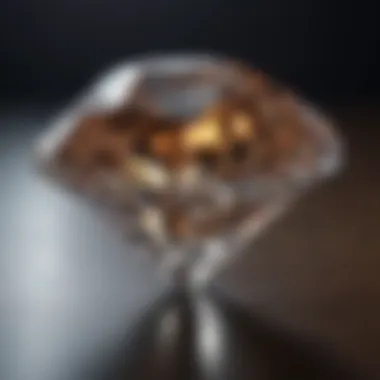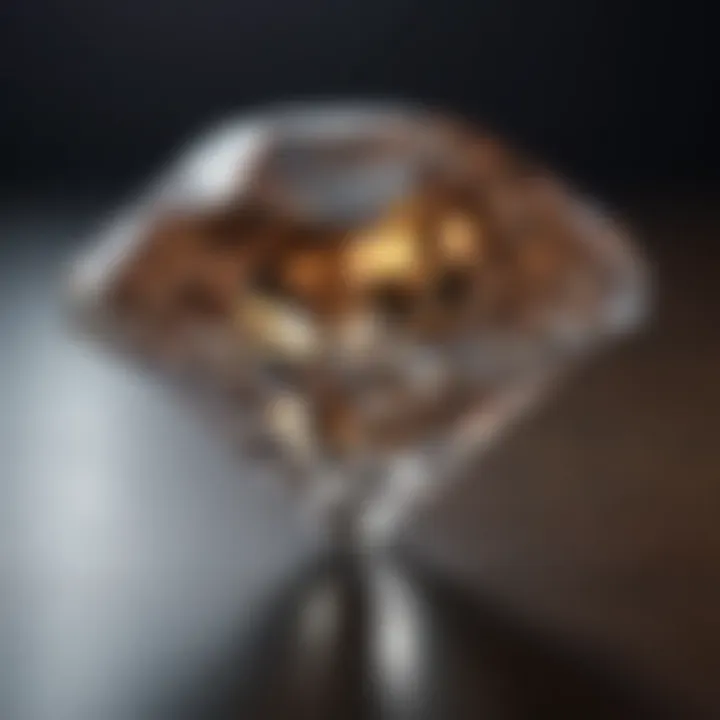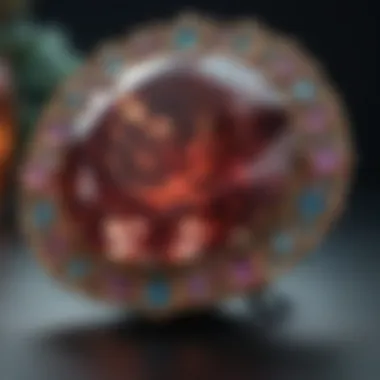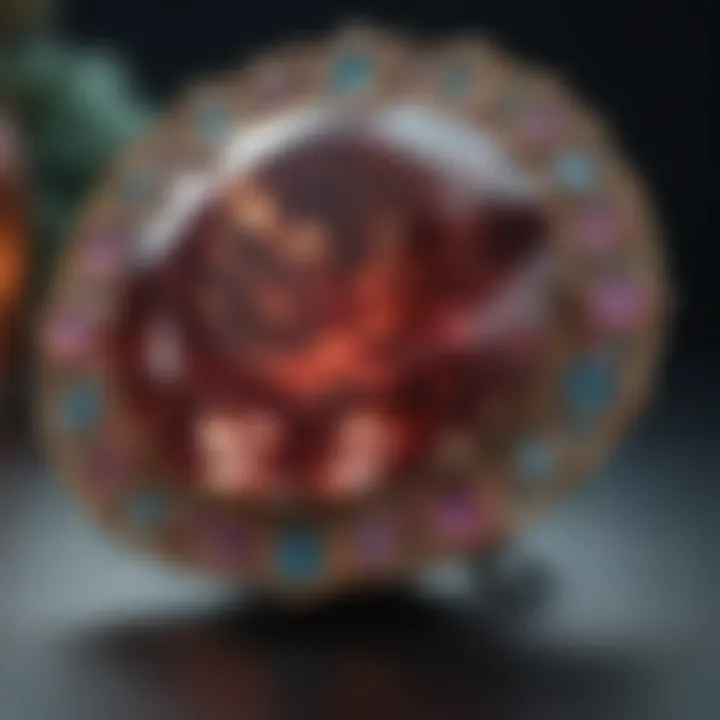The Most Valuable Gem: An In-Depth Exploration


Intro
The world of gemstones is a fascinating tapestry woven from layers of history, culture, and science. As we embark on this exploration, it’s essential to grasp not just the glint and shine of these precious stones, but the rich stories they tell. For gemstone enthusiasts, collectors, and jewelers, understanding the significant factors that contribute to the value of gems can enrich both appreciation and investment decisions.
Gemstone Overview
Definition and characteristics
Gemstones, those splendid treasures of the earth, are defined as minerals that have been cut and polished for use in jewelry and ornamentation. But they are more than just pretty objects; they often embody a unique combination of attributes that elevate them to status symbols. Rarity is one among several key characteristics, alongside clarity, color, and cut, which together determine a gemstone's allure and worth.
Classification of gemstones
Gemstones can be broadly classified into two main categories: precious and semi-precious.
- Precious gemstones include diamonds, rubies, sapphires, and emeralds, known for their exceptional quality and rarity.
- Semi-precious gemstones encompass a wider array of stones like amethyst, aquamarine, and garnet. While they may not carry the same price tag, they hold beauty and charm in their own right.
it’s essential to note that the classification often reflects societal perceptions rather than inherent value.
Properties of Gemstones
Physical properties
The physical properties of gemstones significantly impact their desirability and valuation. Factors to consider include:
- Hardness: Measured on the Mohs scale, hardness determines a stone's resistance to scratching. Diamonds, for instance, sit at the top, making them exceptionally durable.
- Luster: The way light reflects off a stone's surface, giving it a shiny appearance, can vary from vitreous to metallic, influencing the gem's overall appeal.
- Transparency: Ranging from transparent to opaque, a gem's clarity can greatly affect its value; it’s often the clean, clear stones that fetch a higher price.
Chemical properties
On the molecular level, the chemical properties of a gemstone determine its color, durability, and overall aesthetic. Key points include:
- Composition: Each gemstone is made of different chemical elements which contribute to its unique hue and characteristics. For example, the presence of chromium in emeralds gives them their vibrant green color.
- Stability: Some gemstones are more stable than others; for instances, opals are susceptible to changes in temperature and humidity, which can crack them.
- Refractive index: This property reflects how light bends when entering a gemstone. A higher refractive index usually correlates with more brilliance and fire.
"Understanding the intricate details of how gemstones are classified and what makes them unique is the bedrock of appreciating these natural wonders."
In summary, recognizing the characteristics that define gemstones and understanding their properties sheds light on their worth in both the jewelry market and cultural contexts. This foundational knowledge sets the stage for a deeper exploration into the most valuable gems and their compelling histories.
Prologue to Gem Value
Understanding the value of gemstones is pivotal for both enthusiasts and those within the jewelry industry. It isn’t merely about their beauty or intrigue; the factors influencing a gem's worth are intricate, weaving together elements of culture, geography, and even market trends. This article seeks to shine a light on why some gems command staggering prices while others linger in relative obscurity.
Understanding Value in Gemstones
When talking about gem value, one must consider three main pillars: rarity, quality, and demand. Each plays a crucial role in setting the price. Rarity tends to grab attention first—especially with stones like diamonds and rubies that have captivated humankind for centuries. These gems are not simply pretty; their scarcity transforms them into objects of desire, almost akin to a treasure hunt. People chase these shinny pieces not just for adornment but as symbols of wealth and status.
Quality, on the other hand, dives deeper into the attributes of the gemstone itself. Factors such as clarity, the intensity of color, and the cut significantly affect a gemstone’s desirability. A beautifully cut diamond can capture light in ways that a poorly cut one cannot, making it more valuable right off the bat. This notion isn’t confined to diamonds—many gemstones, including emeralds and sapphires, also have their own specific quality indicators that define their worth.
The third pillar, demand, is sometimes regarded as the wild card. Market fluctuations can elevate or diminish a gem’s value rapidly. For instance, sapphires saw a surge in popularity as celebrities donned them in place of traditional diamonds, driving up their prices significantly. Collectors and investors want in on the action, fueling a marketplace where some gems become as coveted as high-end stocks.
With this foundation set, one can appreciate the extensive dynamics at play when delving into the world of gemstones.
Historical Context of Gem Valuation
Gem valuation is rooted in rich history, dating back to ancient civilizations. Cultures from the Egyptians to the Greeks placed tremendous significance on gemstones, often intertwining them with mythology and status. The ancient Egyptians saw lapis lazuli as an object of spiritual power, and it was used in ornaments and jewelry for their pharaohs.
The Middle Ages saw the rise of colored gemstones, which were thought to possess protective powers. These beliefs helped fuel their desirability during a time when society was gripped by superstition, further embedding gems in the fabric of culture and commerce. According to historical data, it was during the Renaissance that the appreciation for gemstones evolved into what we recognize today—with crowns, tiaras, and royal regalia sparkling with expertly cut stones.
In modern times, the role of gemstone valuation has shifted but not fundamentally changed. While the stones still carry cultural significance, they have increasingly become commodities in the world of finance and investment. The interplay of historical values and contemporary trends enriches our understanding of why certain gems have reached astronomical valuations.
"When you look at a gemstone, you're not just seeing a piece of nature—you're witnessing history, culture, and emotion melded into a sparkling work of art."
This exploration allows collectors, investors, and enthusiasts alike to not just determine how much a gem may be worth today, but also to understand the forces that have shaped their allure and value through the ages.


Criteria for Valuation
Understanding the crucial criteria for valuation of gemstones is at the heart of discerning what makes certain gems highly sought after. Valuation is more than just a price tag; it involves an intricate evaluation of various features that contribute to the gem’s allure and market worth. This section digs deep into three key elements: rarity, quality, and demand.
Rarity: The Core Component
Rarity stands as the cornerstone of gemstone valuation. The world is full of beautiful stones, but only a handful possess the quality of being truly rare. Rarity is not solely defined by how uncommon a gemstone is. It also includes its availability, geographic sources, and how much of it can be extracted. For instance, imagine a gem that is only found in a specific region — like tanzanite, which is exclusively mined in Tanzania. This geographic limitation can drive its value sky-high.
Furthermore, factors like market trends can fluctuate the perception of rarity. A once-abundant stone might become highly valued if desire outstrips supply, transforming its market standing overnight. Therefore, understanding the dynamics of rarity helps collectors and jewelers navigate the world of valuable gems.
Quality: Grades and Standards
Quality is a multi-faceted element involving several criteria that collectively determine how valuable a gem is. High-quality gems typically exhibit exceptional clarity, vibrant color, and expert cutting. These attributes ensure that a gemstone is not only aesthetically pleasing but also structurally sound. When we examine quality, it’s imperative to delve into two critical aspects: clarity and color as well as cut and carat weight.
Clarity and Color
Clarity refers to a gemstone's internal characteristics; it includes inclusions or blemishes, which can significantly affect its overall quality. A flawless diamond is far rarer and thus infinitely more valuable than one with visible inclusions. Color plays an equally pivotal role in determining the worth of a gem. A vivid red ruby, for instance, commands a much higher price than a pale pink one. What’s critical to understand is that while different individuals may have varying preferences, the most sought-after colors often yield greater monetary value.
The brilliance of gemstone colors — be it the deep green of an emerald or the vibrant blue of a sapphire — often leads them to be favored in jewelry designs. In this context, clarity and color are indispensable attributes that enhance a gem's marketability.
Cut and Carat Weight
Cut refers not just to the shape but also to the craftsmanship of the gemstone. A well-cut gem reflects light beautifully, enhancing its luster and visual appeal. For example, the way a diamond is cut can significantly affect how it sparkles, making the cut a vital factor in its valuation. Additionally, carat weight is a determinant that influences price — larger stones often fetch higher values simply due to their size and rarity.
However, it’s crucial to note that a larger gemstone does not automatically mean higher quality. A 5-carat diamond that is poorly cut may be worth less than a meticulously cut 2-carat stone. Ultimately, working together, cut and carat weight enhance a gem's desirability and price.
Demand and Market Trends
Demand is a fluctuating beast, changing with fashion, culture, and even world events. Trends can dramatically elevate the worth of certain gems; for instance, the growing interest in ethically sourced stones has significantly affected the markets for certain gemstones. Collectors and buyers are now more mindful about the origins and sustainability of gems.
Moreover, seasonal trends can dictate which gems are in favor; during wedding seasons, for instance, demand for engagement rings soars, often bringing diamonds and sapphires to the forefront. Market trends highlight the importance of adaptability for jewelers and traders alike, allowing them to capitalize on changing preferences.
In summation, the valuation of gemstones involves a thorough understanding of rarity, quality, and demand — each element playing a vital role in determining a gem’s true worth.
The Most Valuable Gemstones
The world of gemstones is vast, with each stone telling a unique story shaped by nature, history, and culture. Understanding the most valuable gemstones not only enhances one's appreciation of these rare treasures but also illuminates the intricate workings of the gem market. In this journey, we explore the prominent gemstones, examining what makes them stand head and shoulders above the rest. The allure of gemstones often lies in their exceptional qualities and, frequently, their ability to invoke emotion, desire, and status. Whether you’re a collector, a jeweler, or just a fan of the glimmer, understanding these gems can transform your perspective on beauty and value.
Diamond: The Quintessential Gem
Diamonds are often considered the pinnacle of gemstones, revered for their unrivaled brilliance and lasting appeal. They epitomize luxury and have become a must-have in many jewelry collections. But diamonds come in various types, each with unique properties that cater to different tastes and preferences.
Types of Diamonds
Diamonds are not a one-size-fits-all gem; they break down into several types based on origin, color, and clarity. The primary categories include natural diamonds, synthetic diamonds, and fancy color diamonds. Each type brings its own flavor to the table– for instance, fancy color diamonds can exhibit hues ranging from blue to pink, adding an artistic touch to traditional bling. The uniqueness of colored diamonds often leads collectors to pay a premium for those with exceptional saturation or rare colors, making them a sought-after choice. However, the variations can lead to confusion for buyers unfamiliar with the specifics.
Notable Diamonds in History
Certain diamonds capture the imagination of gem enthusiasts and historians alike due to their storied pasts. Take the Hope Diamond, for example: steeped in legend and said to bring misfortune to its owners, it continues to attract attention and intrigue. Such diamonds not only hold value based on their physical qualities but also on their rich histories and spectacular narratives. This blend of allure and legacy solidifies their place in the gemstone hierarchy. Each one tells a captivating tale of wealth, power, or even tragedy, illuminating the complex history of the diamond trade.
Ruby: The Royal Stone
Rubies are often referred to as the king of gemstones, renowned for their vivid red color and exceptional hardness, second only to diamonds. They hold a special place in both royal and personal collections.
Origins of Ruby
Rubies have a fascinating origin story, tracing back to Asia, specifically Myanmar, which once produced the world’s best rubies. The purest rubies are known for their rich, pigeon blood red hue, which is often sought by collectors and jewelers alike. When assessing the worth of a ruby, the origin can significantly influence market value, as stones from certain locales are perceived as more valuable due to their unique characteristics.
Comparative Rarity Against Other Gems
Rubies hold a distinct position in terms of rarity compared to many gemstones. While some gems are abundant and widely available, high-quality rubies are scarce, resulting in increased market demand. The rarity of top-tier rubies, especially those exhibiting extraordinary color and clarity, pushes their value higher, marking them as a sought-after find. The quest for that perfect ruby can be akin to finding a needle in a haystack, which adds to their allure as prized possessions.


Emerald: The Gem of the Gods
Emeralds are often thought of as the epitome of color, known for their lush green tones that evoke feelings of renewal and vibrance. Their sudden rise to fame in the world of gems correlates with their symbolic representation of fertility, rebirth, and wealth.
Historical Significance
Historically, emeralds were cherished by ancient civilizations, including the Egyptians who adorned their kings and queens with these precious stones. The allure of emeralds transcends time and culture, representing not just luxury but also spiritual power in some societies. Their historical significance imbues them with a sense of mystique, drawing enthusiasts to explore more than their aesthetic appeal.
Color and Clarity in Value Determination
The quality of emeralds is often measured by their beautiful green color and clarity. Unlike diamonds, which are graded based on cut and clarity, emeralds are often valued for color first. The richest green tones combined with high clarity command higher prices in the market. However, having inclusions or 'jardin' (as they are called in the industry) may not significantly reduce a stone’s worth if the color is captivating enough. This nuance in valuation can sometimes generate puzzlement among new collectors, depicting the complexity involved in assessing emeralds.
Blue Sapphire: Symbol of Purity
Blue sapphires are seen as symbols of wisdom and nobility, often associated with their deep blue hues. Their appeal lies not just in aesthetics but also in the beliefs surrounding them.
Different Varieties and Their Worth
Sapphires aren't limited to blue; they come in a rainbow of colors. However, blue sapphires have reigned supreme in market value. Factors such as origin (with Kashmir and Burmese sapphires commanding higher prices), cut, and clarity all contribute to their overall valuation. Unique localities breed unique characteristics. One might find that a gemstone from Kashmir sells for a far greater price than similar stones from elsewhere, creating a disparity based on rarity.
Colloquial Value Perceptions
The perception of sapphire's value varies across cultures. In some Asian cultures, sapphires are believed to bring good fortune, which can elevate their desirability. This cultural significance can shift market trends as collectors seek out sapphires not just for their physical beauty, but also for the stories and beliefs tied to them. The different contexts in which these stones are appreciated provide intriguing insights into the psyche of gemstone valuation.
Alexandrite: The Color-Changing Phenomenon
Known for its breathtaking color change from green in daylight to a deep red under incandescent light, alexandrite is one of the rarest gemstones. This remarkable optical phenomenon, along with its scarcity, makes it an object of desire for serious collectors.
Unique Optical Properties
Alexandrite stands out from its peers due to its unique optical qualities. The ability to change color depending on the light striking it adds an element of intrigue. This quality can significantly impact its pricing, depending on the intensity of the color change. The more pronounced the shift, the more valuable the stone. Consumers often find this captivating feature a delightful conversation starter, making it a particularly treasured piece in gemstone collections.
Market Scarcity and Value
Alexandrite is scarce; finding high-quality specimens is becoming increasingly challenging. The market’s growing demand alongside the limited supply causes prices to rise. Yet, this scarcity can be a double-edged sword. While it can heighten the gem's value, it may also make it harder for potential buyers to discover genuine articles amidst a flood of lesser-quality imitations. Therefore, understanding the market dynamics surrounding alexandrite is critical for any serious collector.
By exploring these fascinating gemstones, we open a window to the complexities and intricacies of the gem world. Each one bears its own story, with its worth rooted in a blend of beauty, rarity, and historical significance.
Emerging Gemstones of Value
When we talk about valuable gemstones, it’s easy to get swept away by the classics: diamonds, rubies, and emeralds. However, there’s a new wave of gems making a splash in the market, drawing the attention of collectors and designers alike. Emerging gemstones are not just a fleeting trend; they represent a significant shift in how value is perceived in the gemstone world. The importance of discussing these stones lies in their unique characteristics, their potential for future appreciation, and the role they play in sustainable practices in the jewelry industry.
By focusing on these fresh contenders, we broaden the understanding of gem value, recognizing that beauty and rarity can emerge from less well-known sources. For those involved in the gem trade, these stones offer new opportunities for investment and innovation.
Tanzanite: A Recently Discovered Treasure
Tanzanite, discovered only in the 1960s in Tanzania, has quickly carved out an identity for itself. This gemstone stands apart for its remarkable color, which can shift from deep blue to violet, depending on the light. It's not just the color that attracts attention; the way light dances through the crystal gives it a captivating appearance.
Given its relatively recent entry into the market, tanzanite is rapidly gaining value and interest among investors and collectors. One might say its rise has been nothing short of meteoric. With tanzanite, collectors are not just buying a gem; they are investing in a piece of history that is still forming.
The mine where tanzanite is sourced is the only one in the world, and with finite resources, experts project potential scarcity. As supplies dwindle, prices are expected to soar. For the discerning eyes of the jewelry designer or collector, having even a modest piece of this gem can set a collection apart.
Opal: A Canvas of Color
Opal is known as a canvas of color for a reason. It's like nature’s artwork, showcasing a mesmerizing play of color that can be both subtle and vibrant. Each individual stone tells its own story through an interplay of hues, often displaying greens, reds, blues, and yellows in captivating patterns. Such beauty has turned opals into a sought-after choice, especially among those who appreciate unique, one-of-a-kind items.
Moreover, opals carry a sense of personal significance. They are often regarded as symbols of hope and purity. This emotional connection can significantly enhance their perceived value. With ongoing global interest in sustainable sourcing, the environmental impact of opal mining is also receiving more scrutiny, thus, ethical practices can further improve the marketability and desirability of opals.
In the evolving landscape of gemstones, both tanzanite and opal present compelling narratives. Their unique qualities not only captivate the senses but also reflect broader cultural values in terms of sustainability and individuality. As these gems continue to gain traction, understanding their significance will be key for anyone involved in the intricate world of precious stones.
Cultural and Symbolic Aspects of Valuable Gems


Understanding the cultural and symbolic significance of gemstones adds another layer of appreciation for these natural treasures. When examining gemstones, one cannot overlook their impact on human life across different societies and eras. From ancient civilizations to modern-day jewelry trends, the significance and associations of gems often reveal deep-seated cultural beliefs and values.
Gemstones in History and Mythology
Throughout history, gemstones have served as more than mere decoration; they have played pivotal roles in mythology and religious practices. For instance, ancient Egyptians revered lapis lazuli, believing it brought protection and wisdom. This blue stone wasn’t just used in jewelry; it adorned the burial masks of pharaohs, signifying importance in the afterlife.
Similarly, the ancient Greeks associated pearls with the goddess Aphrodite, symbolizing love and beauty. Pearls, due to their unique formation, were seen as rare and precious, much like love itself. Such associations provide insight into how societies viewed human experiences and values, often imbuing gemstones with a form of spiritual currency.
"Gemstones reflect our history like a mirror held to the past, capturing the essence of times long gone."
As we shift to the East, we find that rubies have held remarkable status in Indian culture. The belief that rubies could grant victory and protection has made them integral to royal adornments. Such stories elevate the value of these gems beyond their physical properties, anchoring them in legends and traditions.
Additionally, amethyst was historically thought to prevent intoxication. Greek soldiers would often wear it in battle, believing it offered protection. The metaphorical meanings layered onto gemstones make them fascinating case studies for sociocultural exploration.
Modern Perceptions and Associations
Today, the cultural significance of gemstones continues to evolve. In contemporary society, diamonds are often marketed as symbols of love and commitment, gracing engagement rings with a promise of eternal devotion. This notion, deeply embedded in modern wedding customs, has transformed the diamond into a must-have for couples, thus solidifying its value.
Moreover, colored gemstones, like sapphires and emeralds, are gaining newfound popularity as preferences shift toward more personal and unique expressions of style. Trends reflecting individuality steer consumers towards alternatives, enriching the symbolism of gems in personal identity.
The rise of sustainable and ethically sourced jewelry has also influenced how people associate gems with values like environmental consciousness and social justice. Shoppers nowadays often look for transparency in sourcing, aligning their values with those of the artisans who craft the jewelry.
In essence, the cultural and symbolic aspects of gemstones paint a vivid picture of human values across time and context. As collectors and enthusiasts explore these gems, they not only appreciate their beauty but also the rich tapestry of meanings that each stone holds.
The Future of Valuable Gemstones
As we gaze into the crystal ball of gemstone valuation, a few key trends and changes come into sharp focus. The future is set to be shaped not just by the classic criteria of rarity and beauty, but also by the growing consciousness of sustainability and technological advancements. These factors are influencing both consumer preferences and industry practices in significant ways.
Sustainability and Ethical Sourcing
The concept of sustainability isn't just a buzzword anymore; it has found its way into the very bedrock of many industries, including gemstones. Today's consumers are becoming increasingly aware of how gems are sourced. From conflict diamonds to the environmental impact of mining, the conversation around ethical sourcing is transforming how gems are perceived and valued.
Since the 21st century began, there has been a notable shift towards more responsible mining practices. Brands like Brilliant Earth and Gemfields are leading the charge, ensuring that their gemstones are ethically sourced. This includes following traceable supply chains that minimize harm to the environment and support local communities.
- Raising Awareness: Educational campaigns and certifications now help buyers identify ethically sourced gemstones. Awareness has grown from a niche consideration to a standard expectation among discerning consumers.
- Impact on Pricing: While ethical gems might come with a heftier price tag due to their sourcing practices, many consumers are willing to pay the premium for peace of mind. They see it as an investment not just in beauty but also in principles.
Furthermore, the shift towards sustainable practices benefits the gemstone industry itself. Less harmful mining methods tend to lead to more stable environments which can support the long-term viability of mining operations.
Technological Innovations in Gem Valuation
The realm of gemstone valuation is witnessing remarkable advancements due to technology. Innovations such as blockchain are beginning to mark their territory, promising improved transparency and trust for buyers and sellers alike.
- Blockchain Applications: This technology provides a secure ledger for tracking a gemstone’s journey from mine to market. It can effectively eliminate fraud and ensure that each gem has a verified provenance.
- Grading Technology: Modern techniques are being employed to assess the quality of gemstones with unmatched precision. High-resolution imaging and AI algorithms are helping gemologists classify stones more accurately, improving the grading system beyond traditional methods.
Moreover, augmented reality is even making waves in the marketing of gemstones. Consumers can visualize how a particular gem would look in a piece of jewelry before making a purchase, leading to more informed buying decisions.
Both sustainability and technology are set to redefine not just how diamonds and other precious stones are sourced and valued, but also how they are perceived in society. As these trends develop, the future of valuable gemstones promises to be a blend of ethics and innovation, offering a more sustainable approach while retaining the allure that collectors and jewelry enthusiasts have cherished for centuries.
"People want beautiful gems that also respect the planet. This evolutionary mindset is reshaping market dynamics."
Closure
In the end, the future of valuable gemstones appears bright yet complex, characterized by consumers who value ethics and authenticity as highly as brilliance and craftsmanship. As we move forward, the dialogue surrounding gemstones will continue to evolve, capturing the essence of what it means to invest in beauty that resonates with values.
Finale
Drawing this discussion to a close, it's imperative to reflect on the significance of understanding the nuances surrounding the value of gemstones. Gems are more than mere ornaments; they act as touchstones of cultural heritage, economic development, and personal connection. In this article, we've navigated through various aspects, from rarity and quality to the cultural symbolism these stones hold in society.
The elements we discussed highlight why valuing gems is a multifaceted endeavor. Rarity often plays a starring role, as the scarcity can drive prices sky-high. However, it's not just about how rare something is. Quality—considering clarity, color, and cut—shapes how a stone is perceived and appreciated.
Emerging trends and market demands paint a lively picture that can sway the valuation as well. For collectors and jewelry designers alike, understanding these nuances can mean the difference between looking at a rock and seeing the potential investment it represents.
Moreover, the conversation of sustainability and ethical sourcing should also not be sidelined. As consumers grow more conscious about the origins of their gems, modern perceptions increasingly intertwine profit with responsibility. This shift is something the industry can’t afford to overlook.
"The true value of a gemstone lies not just in its monetary worth but in the stories, connections, and values that it represents."
In summary, appreciating gemstones requires digging deep into their intricacies. The interplay of historical context, market dynamics, and personal significance forms a tapestry that enriches our understanding of why certain stones are held in such high regard. As we move forward, let’s *carry this knowledge in our hearts, as much as we wear these beautiful creations as adornments. *



